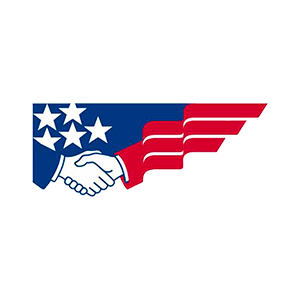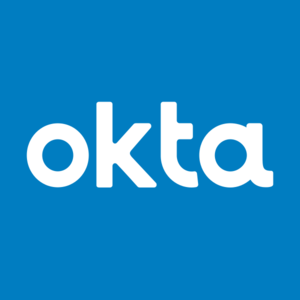
SentinelOne (S)
SentinelOne is intriguing. Its elite ARR growth suggests it not only generates recurring revenue but also is winning market share.― StockStory Analyst Team
1. News
2. Summary
Why SentinelOne Is Interesting
Built on the principle of "fighting machine with machine," SentinelOne (NYSE:S) provides an AI-powered cybersecurity platform that autonomously prevents, detects, and responds to threats across endpoints, cloud workloads, and identity systems.
- Impressive 68.9% annual revenue growth over the last five years indicates it’s winning market share
- ARR growth averaged 26.3% over the last year, showing customers are willing to take multi-year bets on its software
- A drawback is its rapid expansion strategy came at the expense of operating margin profitability


SentinelOne shows some potential. If you like the company, the price looks fair.
Why Is Now The Time To Buy SentinelOne?
High Quality
Investable
Underperform
Why Is Now The Time To Buy SentinelOne?
SentinelOne is trading at $17.03 per share, or 5x forward price-to-sales. SentinelOne’s valuation seems like a good deal for the revenue momentum you get.
If you think the market is undervaluing the company, now could be a good time to build a position.
3. SentinelOne (S) Research Report: Q3 CY2025 Update
Cybersecurity AI platform provider SentinelOne (NYSE:S) reported revenue ahead of Wall Streets expectations in Q3 CY2025, with sales up 22.9% year on year to $258.9 million. On the other hand, next quarter’s revenue guidance of $271 million was less impressive, coming in 0.8% below analysts’ estimates. Its non-GAAP profit of $0.07 per share was 31.5% above analysts’ consensus estimates.
SentinelOne (S) Q3 CY2025 Highlights:
- Revenue: $258.9 million vs analyst estimates of $256.1 million (22.9% year-on-year growth, 1.1% beat)
- Adjusted EPS: $0.07 vs analyst estimates of $0.05 (31.5% beat)
- Adjusted Operating Income: $17.67 million vs analyst estimates of $10.2 million (6.8% margin, 73.2% beat)
- Revenue Guidance for Q4 CY2025 is $271 million at the midpoint, below analyst estimates of $273.2 million
- Operating Margin: -28.3%, up from -42.3% in the same quarter last year
- Free Cash Flow was $15.9 million, up from -$7.15 million in the previous quarter
- Customers: 1,572 customers paying more than $100,000 annually
- Annual Recurring Revenue: $1.06 billion vs analyst estimates of $1.05 billion (22.8% year-on-year growth, in line)
- Market Capitalization: $5.68 billion
Company Overview
Built on the principle of "fighting machine with machine," SentinelOne (NYSE:S) provides an AI-powered cybersecurity platform that autonomously prevents, detects, and responds to threats across endpoints, cloud workloads, and identity systems.
SentinelOne's Singularity Platform represents a significant shift from traditional, human-dependent cybersecurity approaches to an AI-driven autonomous defense system. At its core, the platform employs three types of artificial intelligence: Static AI that identifies malicious files in milliseconds, Behavioral AI that monitors process activities for threats, and Streaming AI that correlates data across multiple sources to detect anomalies.
The platform creates detailed contextual narratives called "Storylines" for every protected device, enabling security teams to quickly investigate incidents across their digital environment. These Storylines track all events and behaviors occurring on endpoints, cloud workloads, and identity systems, providing analysts with the ability to trace attack progression and automatically remediate compromised systems.
SentinelOne generates revenue through subscription-based pricing tiers for its platform, with options ranging from basic endpoint protection (Singularity Core) to comprehensive enterprise security solutions (Singularity Enterprise). The company's customers span organizations of all sizes across approximately 80 countries, from small businesses to large global enterprises and government entities.
Beyond its core platform, SentinelOne offers additional services including Vigilance Managed Detection and Response (MDR), which provides 24/7 monitoring by the company's security analysts, and WatchTower, which delivers threat intelligence and proactive hunting capabilities. The company has built an extensive partner ecosystem that includes managed security service providers, incident response firms, and technology alliances, allowing SentinelOne to extend its reach and capabilities through integration with other security and IT systems.
4. Endpoint Security
Almost every company is slowly finding itself becoming a technology company and facing cybersecurity risks. As the volume of internet enabled devices grows, every device that employees use to connect to business networks represents a potential risk. Endpoint security software enables businesses to protect devices (endpoints) that employees use for work purposes either on a network or in the cloud from cyber threats.
SentinelOne competes with endpoint security providers like CrowdStrike Holdings, Inc. and VMware Carbon Black, legacy antivirus companies including Trellix (formerly McAfee), Symantec (owned by Broadcom), and Microsoft, as well as broader network security providers such as Palo Alto Networks who offer comprehensive security portfolios.
5. Revenue Growth
A company’s long-term sales performance is one signal of its overall quality. Any business can experience short-term success, but top-performing ones enjoy sustained growth for years. Over the last five years, SentinelOne grew its sales at an incredible 64.9% compounded annual growth rate. Its growth beat the average software company and shows its offerings resonate with customers, a helpful starting point for our analysis.
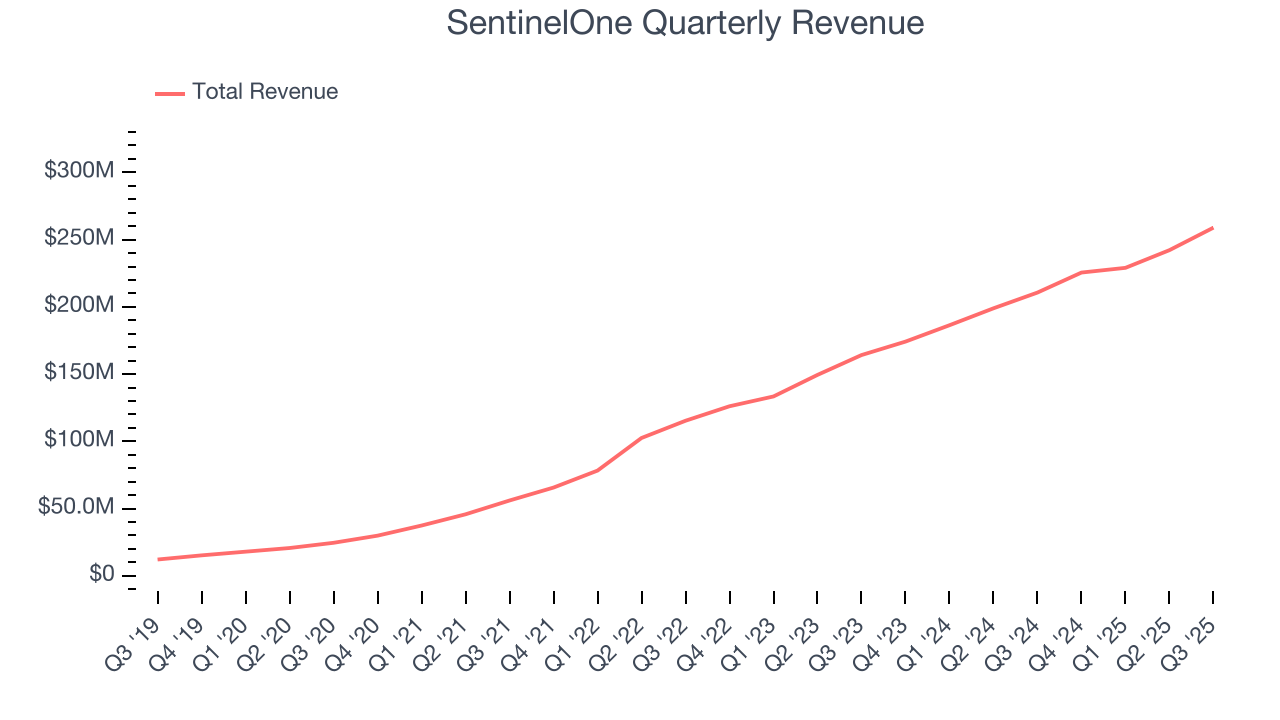
We at StockStory place the most emphasis on long-term growth, but within software, a half-decade historical view may miss recent innovations or disruptive industry trends. SentinelOne’s annualized revenue growth of 29.1% over the last two years is below its five-year trend, but we still think the results suggest healthy demand. 
This quarter, SentinelOne reported robust year-on-year revenue growth of 22.9%, and its $258.9 million of revenue topped Wall Street estimates by 1.1%. Company management is currently guiding for a 20.2% year-on-year increase in sales next quarter.
Looking further ahead, sell-side analysts expect revenue to grow 20.6% over the next 12 months, a deceleration versus the last two years. Despite the slowdown, this projection is admirable and suggests the market is forecasting success for its products and services.
6. Annual Recurring Revenue
While reported revenue for a software company can include low-margin items like implementation fees, annual recurring revenue (ARR) is a sum of the next 12 months of contracted revenue purely from software subscriptions, or the high-margin, predictable revenue streams that make SaaS businesses so valuable.
SentinelOne’s ARR punched in at $1.06 billion in Q3, and over the last four quarters, its growth was fantastic as it averaged 24.6% year-on-year increases. This performance aligned with its total sales growth and shows that customers are willing to take multi-year bets on the company’s technology. Its growth also makes SentinelOne a more predictable business, a tailwind for its valuation as investors typically prefer businesses with recurring revenue. 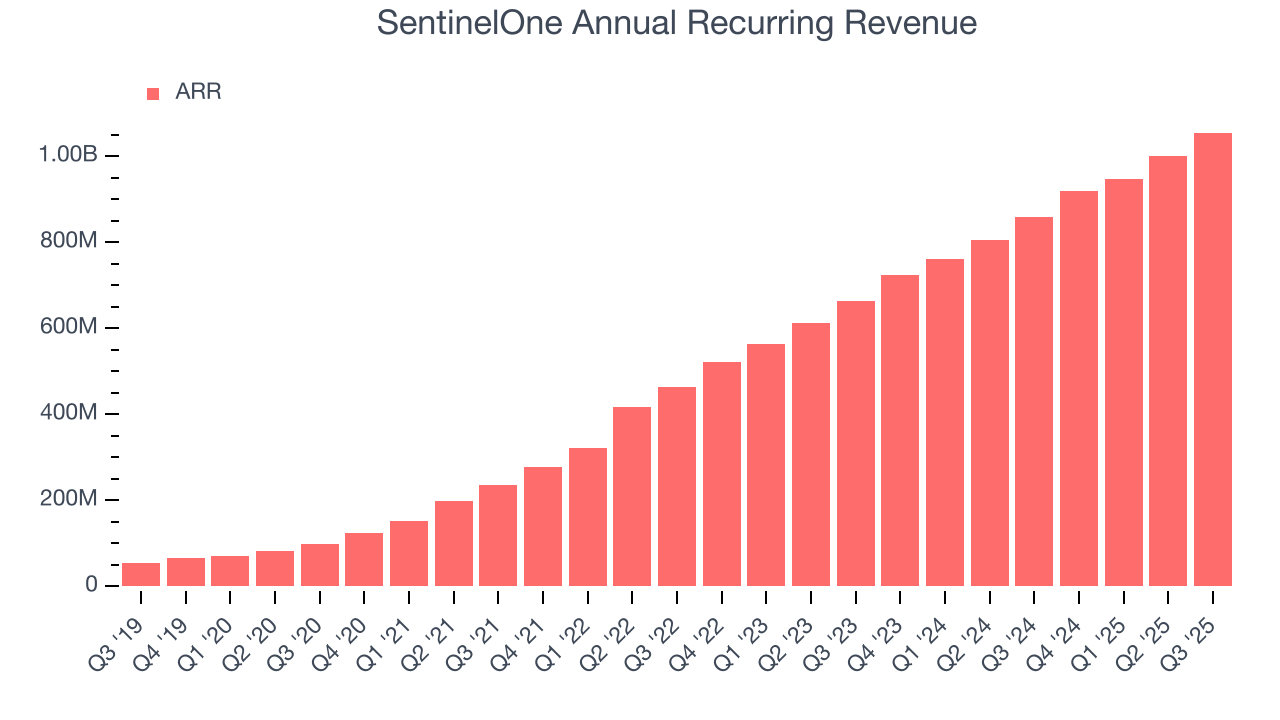
7. Enterprise Customer Base
This quarter, SentinelOne reported 1,572 enterprise customers paying more than $100,000 annually, an increase of 59 from the previous quarter. That’s in line with the number of contract wins in the last quarter but quite a bit below what we’ve observed over the previous year, suggesting that the slowdown we observed in the last quarter could continue. It also implies that SentinelOne will likely need to upsell its existing large customers or move down market to maintain its top-line growth.

8. Customer Acquisition Efficiency
The customer acquisition cost (CAC) payback period measures the months a company needs to recoup the money spent on acquiring a new customer. This metric helps assess how quickly a business can break even on its sales and marketing investments.
It’s relatively expensive for SentinelOne to acquire new customers as its CAC payback period checked in at 62.6 months this quarter. The company’s drawn-out sales cycles partly stem from its focus on enterprise clients who require some degree of customization, resulting in long onboarding periods. The complex integrations are a double-edged sword - while SentinelOne may not see immediate returns from its sales and marketing investments, it is rewarded with higher switching costs and lifetime value if it can continue meeting its customer’s needs. 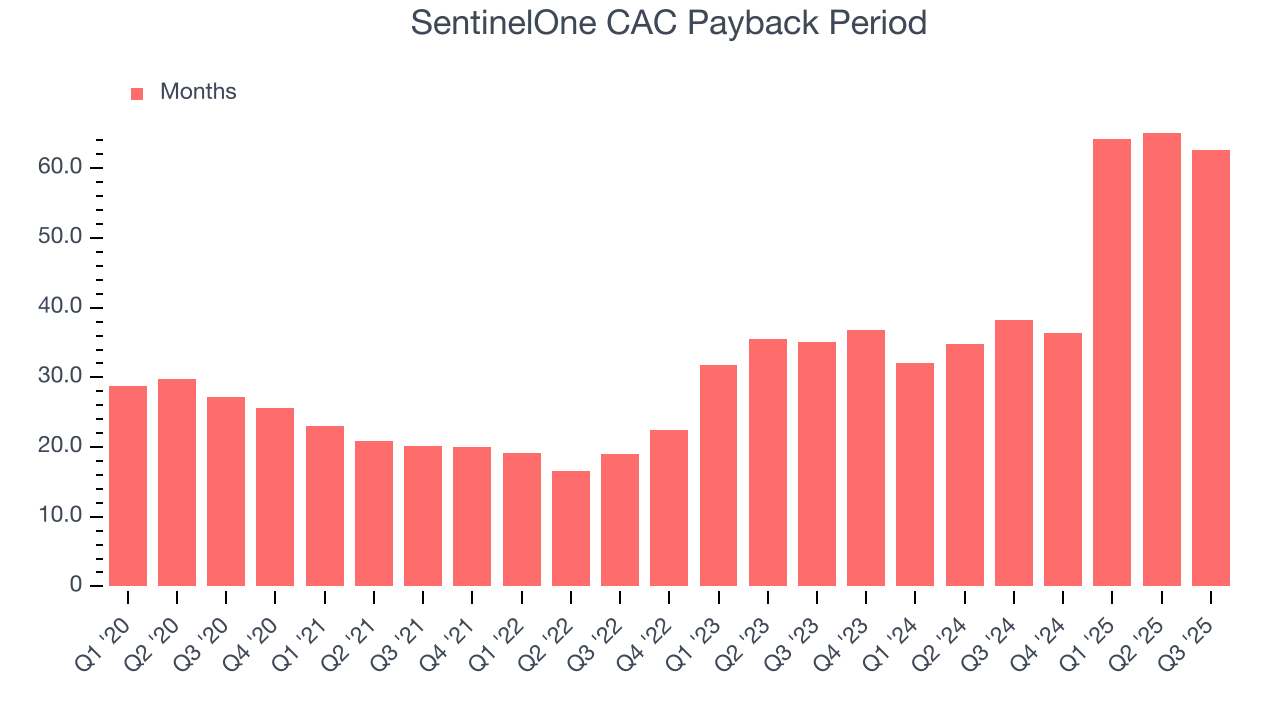
9. Gross Margin & Pricing Power
Software is eating the world. It’s one of our favorite business models because once you develop the product, it usually doesn’t cost much to provide it as an ongoing service. These minimal costs can include servers, licenses, and certain personnel.
SentinelOne’s gross margin is better than the broader software industry and signals it has solid unit economics and competitive products. As you can see below, it averaged a decent 74.7% gross margin over the last year. That means for every $100 in revenue, roughly $74.69 was left to spend on selling, marketing, and R&D.
The market not only cares about gross margin levels but also how they change over time because expansion creates firepower for profitability and free cash generation. SentinelOne has seen gross margins improve by 4.4 percentage points over the last 2 year, which is very good in the software space.
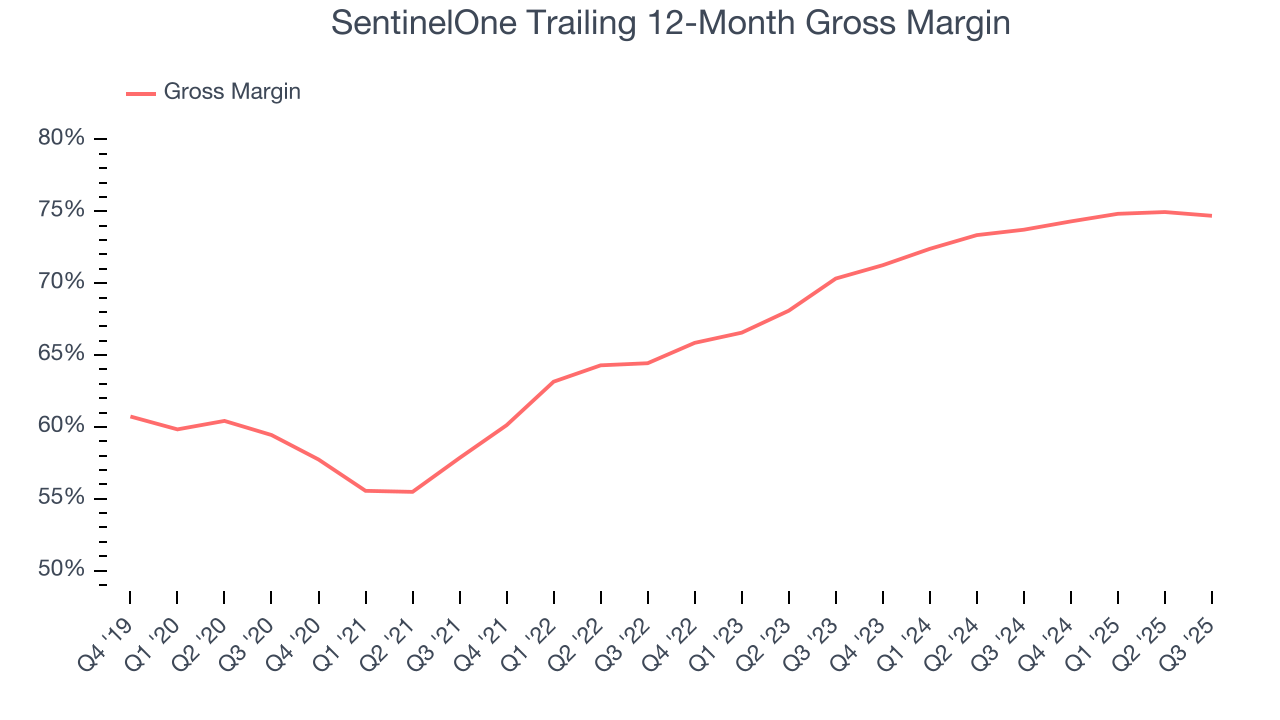
SentinelOne produced a 73.8% gross profit margin in Q3, in line with the same quarter last year. Zooming out, the company’s full-year margin has remained steady over the past 12 months, suggesting its input costs have been stable and it isn’t under pressure to lower prices.
10. Operating Margin
While many software businesses point investors to their adjusted profits, which exclude stock-based compensation (SBC), we prefer GAAP operating margin because SBC is a legitimate expense used to attract and retain talent. This metric shows how much revenue remains after accounting for all core expenses – everything from the cost of goods sold to sales and R&D.
SentinelOne’s expensive cost structure has contributed to an average operating margin of negative 33.7% over the last year. This happened because the company spent loads of money to capture market share. As seen in its fast revenue growth, the aggressive strategy has paid off so far, and Wall Street’s estimates suggest the party will continue. We tend to agree and believe the business has a good chance of reaching profitability upon scale.
Over the last two years, SentinelOne’s expanding sales gave it operating leverage as its margin rose by 9.2 percentage points. Still, it will take much more for the company to reach long-term profitability.
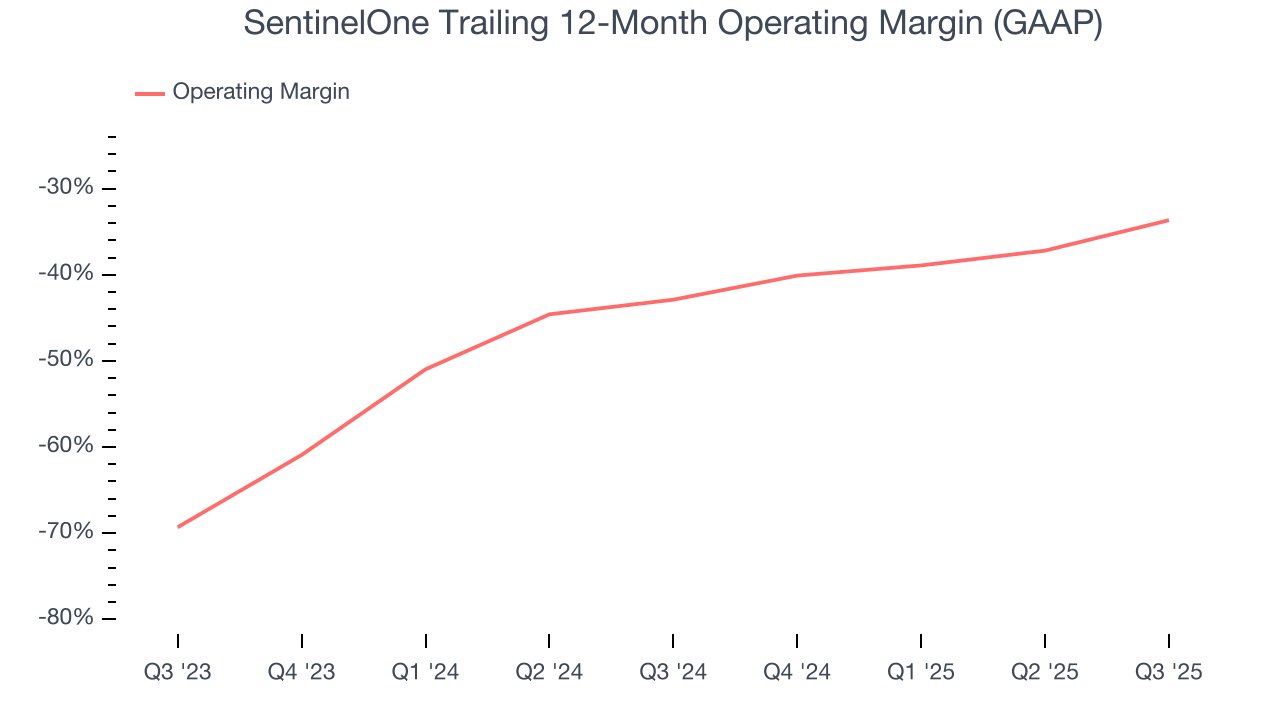
This quarter, SentinelOne generated a negative 28.3% operating margin.
11. Cash Is King
Free cash flow isn't a prominently featured metric in company financials and earnings releases, but we think it's telling because it accounts for all operating and capital expenses, making it tough to manipulate. Cash is king.
SentinelOne has shown poor cash profitability over the last year, giving the company limited opportunities to return capital to shareholders. Its free cash flow margin averaged 4.7%, lousy for a software business.
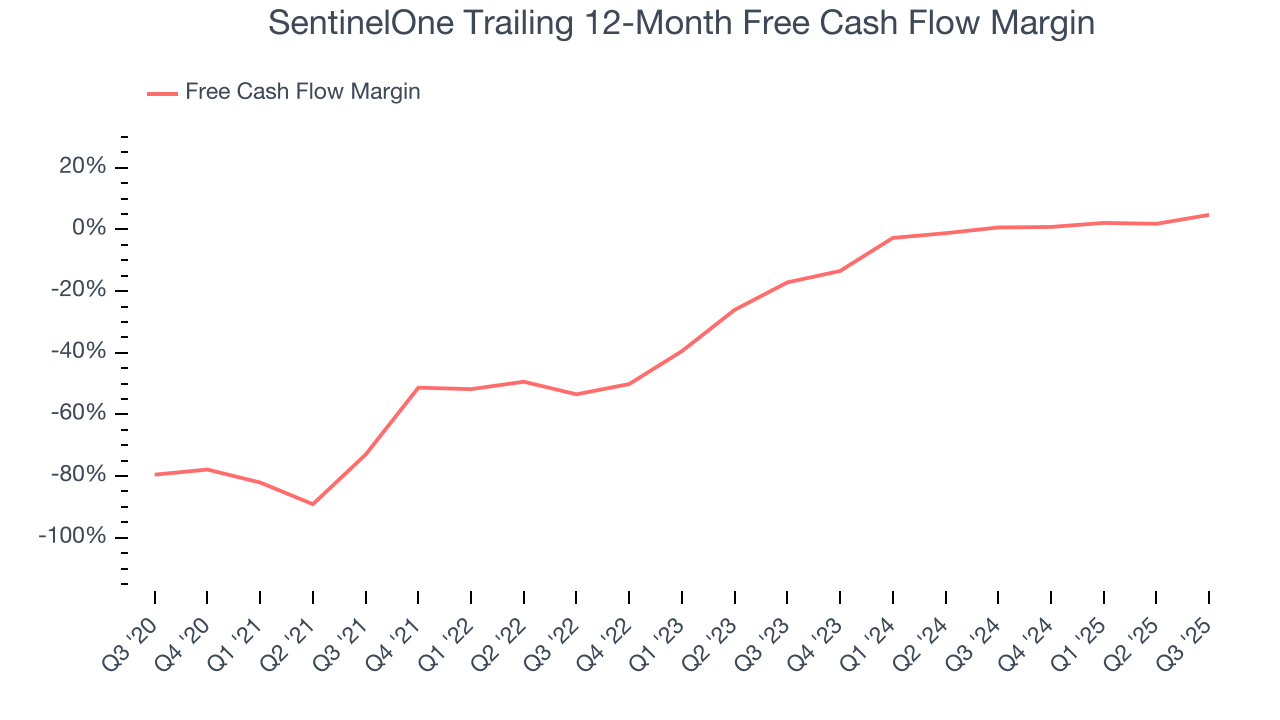
SentinelOne’s free cash flow clocked in at $15.9 million in Q3, equivalent to a 6.1% margin. Its cash flow turned positive after being negative in the same quarter last year. Its cash profitability was also above its one-year level, and we hope the company can build on this trend.
Over the next year, analysts predict SentinelOne’s cash conversion will improve. Their consensus estimates imply its free cash flow margin of 4.7% for the last 12 months will increase to 11%, it options for capital deployment (investments, share buybacks, etc.).
12. Balance Sheet Assessment
One of the best ways to mitigate bankruptcy risk is to hold more cash than debt.

SentinelOne is a well-capitalized company with $649.8 million of cash and no debt. This position is 11.4% of its market cap and gives it the freedom to borrow money, return capital to shareholders, or invest in growth initiatives. Leverage is not an issue here.
13. Key Takeaways from SentinelOne’s Q3 Results
It was good to see SentinelOne narrowly top analysts’ revenue expectations this quarter. On the other hand, its revenue guidance for next quarter slightly missed. Overall, this quarter could have been better. The stock traded down 8.3% to $15.69 immediately after reporting.
14. Is Now The Time To Buy SentinelOne?
Updated: December 4, 2025 at 9:11 PM EST
Before making an investment decision, investors should account for SentinelOne’s business fundamentals and valuation in addition to what happened in the latest quarter.
First of all, the company’s revenue growth was exceptional over the last five years. And while its operating margins reveal poor profitability compared to other software companies, its surging ARR shows its fundamentals and revenue predictability are improving. On top of that, SentinelOne’s gross margin suggests it can generate sustainable profits.
SentinelOne’s price-to-sales ratio based on the next 12 months is 4.9x. Looking at the software landscape right now, SentinelOne trades at a pretty interesting price. For those confident in the business and its management team, this is a good time to invest.
Wall Street analysts have a consensus one-year price target of $23.39 on the company (compared to the current share price of $15.52), implying they see 50.8% upside in buying SentinelOne in the short term.
